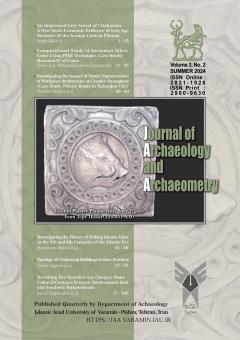Terms of acceptance
- The manuscript must be original research and has not yet been fully or partly published in other journals or monographs. It should not be submitted to the other journals before final decision made by the JAA.
- The author (s) are responsible for the accuracy of all contents presenting in their manuscript.
- The Journal is not necessarily in agreement with the ideas presented in the manuscripts.
- The first author is considered as the corresponding author if it is not specified in the authors’ list.
- The manuscript should be written clearly and free of poor language, spelling mistakes or grammatical errors.
- JAA is free to literary edit the submitted manuscripts.
- The Manuscripts should be submitted as a standalone MS Word (.doc or .docx) file in word 2016 and in A4 format, Times New Roman 12-point font.
- The first page of the manuscript must include name and affiliation of the author (s), email and contact details.
- Arrange your manuscript as follows: title, abstract, keywords, main body including introduction, materials and methods, analysis, discussion, conclusion, acknowledgment, foot note (if applicable) and references.
- The captions for tables should appear above each, and for figures (including diagrams) below. Tables and illustrations must be referred to in the text. Use ‘Fig.’ in the text to refer to a certain figure.
- The figures should be in JPG or TIFF format with minimum resolution of 300 dpi.
- Use a linear scale appropriate to the size of the find, in case of providing actual photos of archaeological finds.
- Since the figures can be published in colour, use neutral colour background for photos.
- In addition to figure captions, which should be grouped with each figure, provide a figure list for all figures and tables in a separate word file. Do not place the figures and tables in the word file text and send all figures as a separate file.
- In case of unfamiliar names of the sites, use diacritical marks adapted by Encyclopaedia Iranica.
Preparation of the manuscript
Note the following details in preparing the manuscript.
- Title; must be clear and indicate the theme.
- Abstract; briefly describes the content of the manuscript including questions, objectives, main points and conclusion. The abstract should be minimum 250 words and does not exceed 300.
- Keywords include 4 to 6 words indicating the theme of the research.
- Main body includes introduction, methodology, materials, analysis, discussion and conclusion, footnotes and references:
a. Introduction; this part includes research questions and objectives as well as the history of scholarship.
b. Methodology; methods and innovations applied in the research are presented in this part.
c. Materials, analysis, discussion; this part includes the main body of the manuscript and can be associated with tables, figures and diagrams. This should explore the significance of the results of the work.
d. Conclusion; overview on the whole research and concluding remarks are presented here. Future research directions could be included in this part as well.
e. Acknowledgment; comes at the end of the manuscript and can include individuals and institutions who provided help during the research.
f. References; should be arranged based on APA instructions as following examples:
1. Referring to a book: Author(s): Author’s surname, Author’s initial(s). 2. Year of publication. 3. Book title (Italic). 4. Place of publication: 5. Publisher. 6. Edition.
Example: Mallory, J. P. (1990). In search of the Indo-Europeans: Language, Archeology and Myth, London: Thames and Hudson.
2. Referring to a journal paper: 1. Author(s): Author’s surname, Author’s initial(s). 2. Year of publication. 3. Article title. 4. Journal title 5. Volume, 6. Pages.
Example: Madjidzadeh, Y. & H. Pittman. (2008). “Excavations at Konar Sandal in the region of Jiroft in the Halil Basin: first preliminary report (2002–2008)”. Iran 46: 69–103.
Referring to a book chapter: 1. Author(s): Author’s surname, Author’s initial(s). 2. Year of publication. 3. Chapter title. 4. Editor(s) 5. Book title (Italic) 6. Place of publication: 7. Publisher. 8. Edition. 9. Pages.
Example 1: Hopper, K. (2017). ‘‘Connectivity on a Sasanian Frontier: Route Systems in the Gorgan Plain of North-East Iran’’. In Eberhard W. Sauer (ed.). Sasanian Persia: Between Rome and the Steppes of Eurasia. Edinburgh University Press. 126-150.
Example 2: Alexeyev,A. Yu. (2017). ‘‘The Scythians in Eurasia’’. In St. John Simpson, Svetlana Pankova (eds.). Scythians: Warriors of Ancient Siberia. London: British Museum. Thames & Hudson, London. 16-31.
4.Referring to an electronic publication (e.g. website): 1. Author(s): Author’s surname, Author’s
initial(s). 2. Year of publication. 3. Website title (Italic). 4. Date accessed, 5. URL.
Example: Hawking, S. 2000. Professor Stephen Hawking’s website. Retrieved 9 February,2009, from http://www.hawking.org.uk/
5. Referring to weblogs: 1. Author(s): Author’s surname, Author’s initial(s). 2. Year of publication, Article date. 3. Blog title (Italic). 4. Article title or web-page. 5. Date accessed, 5. URL.
Example 1: Beard, M. 2013, 8 June. A Don’s Life. [Weblog]. Retrieved 26 July, 2016,from http://timesonline. typepad.com/
Example 2: Comparative, M. 2011, 15 October. The State of Research on Sasanian Painting.
Retrieved 25 July, 2016, from http:// sasanika.org.
6. In-text citations:
- One author: Author’s surname, Publication year: Page no(s): (Pourshariati, 2017: 127-129).
- Two authors: Authors’ surnames, Publication year: Page no(s): (Lawrence and Wilkinson, 2017: 104).
- More than two authors: First author’s surname et al. Publication year: Page no(s): (Shumilovskikh, et al. 2017: 54).


